1. INTRODUCTION
Copernicus first wrote about the rotation of the Earth around its axis in his 1543 treatise «On the rotation of the celestial spheres» [1]. But the exact answer to the question of why this is happening has not yet been found. Many hypotheses have been put forward, but scientists have not yet come to a consensus. According to the most famous of the hypotheses related to the theory of the origin of the planets of the Solar system, the Earth was formed from clouds of cosmic dust, which «huddled together» and formed the core or center of the Earth. Further, other cosmic bodies were attracted to it, upon collision with which the planet began to rotate and the rotation continues by inertia. There is another point of view. Imagine a solar system that is still very young, and its interplanetary space is filled with gas and dust. Planets or protoplanets forming in such a system would slow down due to friction, and their orbit would gradually approach the Sun, and eventually they could fall into the Sun due to the combined effect of friction and gravity. However, science does not provide a complete and exhaustive explanation for the continuous rotation of space objects.
A Galaxy is a gravitationally bound system of stars and star clusters, a gas-dust medium, and dark matter. All components of the universe, including the objects of the Milky Way Galaxy, are in constant motion (in different directions and at different speeds) caused by gravitational forces with a changing gravitational potential in space. Dewey B. Larson, who made a great contribution to the development of space science, in his book «Nothing but Motion: The Structure of the Physical Universe, Volume I» [2], noted that the Universe is not just a space-time structure of matter, as is commonly believed in traditional science. He discovered that the universe is Motion, in which space and time are just two interdependent and non-existent aspects of motion, and have no other meaning.
And all he did was to identify the properties that space and time must necessarily possess in the universe, entirely manifested from motion, and expressed them in the form of a series of postulates. But Dewey B. Larson did not explain the reason for the rotation of planets, stars, galaxies during their movement in the Universe.
2. THE GRAVITATIONAL POTENTIAL OF THE GALAXY
The motion of space objects in the composition of, for example, the Galaxy and their continuous rotation is directly related to gravity (gravitational potential) – the universal fundamental interaction between all material bodies of the gravitationally bound system of the Universe, consisting of galaxies, star clusters, planets, satellites, asteroids, interstellar and interplanetary gas and dust.
An example of the presence of a gravitational potential is the Earth's atmosphere – the density of gases that make up the atmosphere changes (decreases) with distance from the Earth's surface. The density of gas-dust formations, various kinds of matter relative to, for example, the plane of symmetry of the galactic disk and the centers of the spiral arms of the Galaxy also changes. As in the atmospheres of planets, the interstellar medium is densest «at the bottom» (for example, in the plane of the galactic disk) and as you move away from it, the density decreases [3]. An example of the distribution of the gravitational potential in the Galaxy is shown in Fig. 1 [3, Fig. 5].

Fig. 1. Distribution of the gravitational potential in the Milky Way Galaxy
The component due to the baryonic matter of the Galaxy is designated MW (Milky Way), and the component due to dark matter (matter) is designated «Halo DM» (Halo TM). The scale of the size of the Galaxy is 30 kiloparsecs, the size of the dark halo is about ten times larger. That is why, despite the lower density in the center, the total mass of Halo TM exceeds the mass of the Galaxy many times [4].
The fact of the movement of objects in outer space is confirmed not only by astronomical observations, but also by calculations of the speed and direction of their movement. George F. Smoot III, in his Nobel lecture on December 8, 2006, said: «The current best observed dipole (3.358±0.017 mK) indicates that the Solar System is moving at a speed of 368±2 km/s relative to the observable Universe in the direction of galactic longitude l = 263.86° and latitude b = 48.25°» [5]. The forces of gravity between the Sun and the planets, as well as between the planets and their satellites, are balanced by centrifugal forces.
3. ROTATION OF SPACE OBJECTS WHEN THEY MOVE
The laws of physics (mechanics) act in the same way – both on Earth and in Space. Let's start by looking at the simplest examples, for example, the rotation of the wheel due to the resistance force.
In Fig. 2a shows how the resistance force depends on the material of the rubbing surfaces and how these surfaces interact.
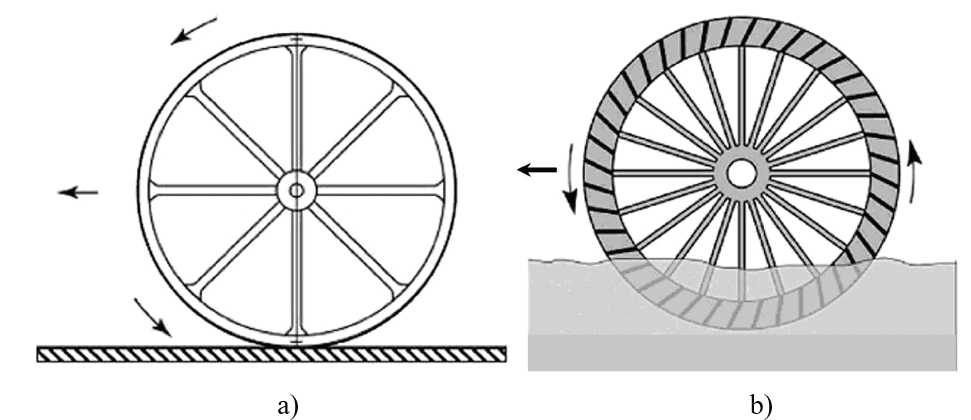
Fig. 2. Rotation of the wheel due to the friction force when moving on a solid surface (a) and the differential drag force: air (above the water level) and water (at the bottom of the wheel) (b)
When a force is applied to the wheel that moves it in a horizontal direction, in this example to the left, the wheel begins to rotate counterclockwise due to the frictional force. In Fig. 2b shows a partially submerged wheel that rotates when driving due to the resulting differential drag force: air (above the water level) and water (at the bottom of the wheel).
Similarly, space objects interact with the interplanetary and interstellar gas-dust media.
In Fig. 3 shows the nature of the interaction of the planet (3a) and the galactic disk (3b) with a gas-dust medium of variable density (density gradient) in which their movement occurs.

а)
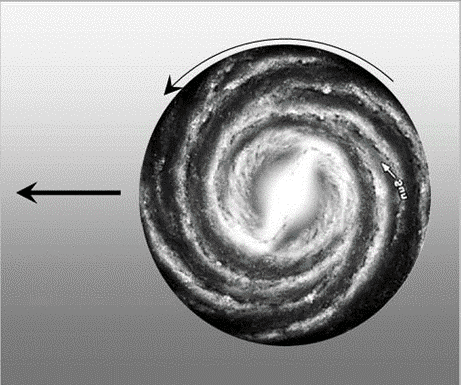
b)
Fig. 3. Interaction of a planet (a) and a galactic disk (b) with an inhomogeneous (changing) density (density gradient) of a gas and dust medium in a plane perpendicular to the direction of motion of these space objects
The lower hemispheres, respectively, of the ball and the galactic disk are subject to greater drag forces due to the greater density of the gas-dust environment washing them than their upper hemispheres.
A comparison of the objects in Figures 2b and 3a confirms the unity of the nature of their rotation, both on Earth and in Space, when the density (density gradient) of the environment in which they move changes: at the bottom of the rotating object a denser medium is shown, and in the upper part – a medium with a lower density.
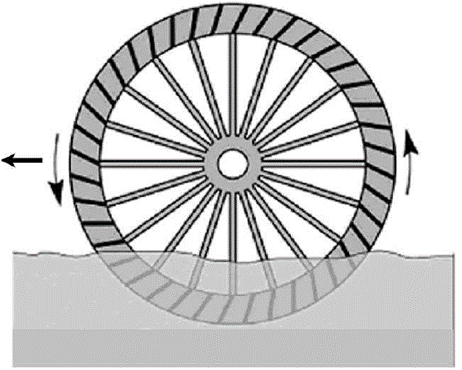
Fig. 2b. Rotation of a wheel partially submerged in water moving in the direction of the arrow to the left
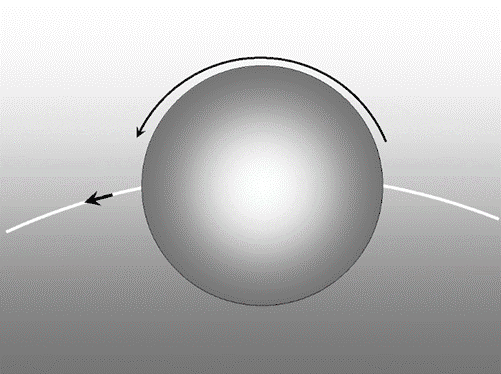
Fig. 3a. Rotation of a planet moving to the left along its orbit in a gas and dust medium with its density gradient relative to the star
In Fig. 4 shows how the resulting force of frontal (frontal) drag ΔF ensures the maintenance of the rotation of the space object when moving in a gas-dust medium that creates its braking.
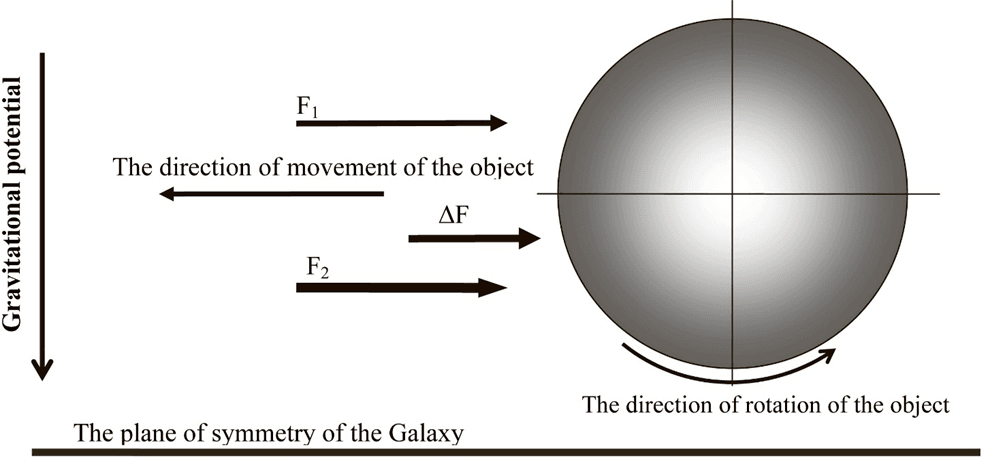
F1 – the resulting drag force of the upper hemisphere;
F2 – the resulting drag force of the lower hemisphere;
ΔF = F2 – F1 is the resulting drag force of the gas and dust medium acting on a spherical space object and maintaining its rotation
Fig. 4. Influence of the resultant drag force of the gas-dust medium on the rotation of a space object during its motion
Consequently, together, friction and the differential (resultant) force of the frontal (frontal) resistance of the gas-dust medium acting on space objects moving in it are the main reason for maintaining their continuous rotation.
When moving in the Galaxy, a specific star system interacts with a specific (local) interstellar matter surrounding it. An example is our star system formed about 5 billion years ago with the Sun (Solar System) with planets, satellites and asteroids continuously rotating around their axes and in orbits.
Due to the heterogeneity of the gas-dust medium in the Galaxy, in the star system there is an oscillation of the angular velocity of rotation (libration), for example, of the Earth, the Moon.
Next, consider the very fact (mechanism) of rotation of a cosmic object.
A special role in the study of the mechanics of the rotation of planets and stars was played by the Foucault pendulum, a pendulum used to experimentally demonstrate the daily rotation of the Earth. The presence of diurnal rotation is responsible for the gradual rotation of the plane of oscillations of the pendulum.
For the first time the effect was demonstrated by L. Foucault (1851), and now in the world there are operating Foucault pendulums used for demonstration purposes.
When the Foucault pendulum moves at the poles of the Earth, the plane of its swing relative to the stars turns out to be stationary, which also became an obvious evidence of the immobility of the Earth's core. Consequently, the cores of planets and stars, as well as the Foucault pendulum at the poles, are stationary relative to the center of the Galaxy. It follows that only their shells (mantle, crust, atmosphere) are subject to continuous rotation due to the external influence on the corresponding object of the gas-dust medium, which has a density gradient.
Confirmation of the immobility of the core of the object is, for example, the slow rotation of Venus (one revolution in 243 Earth days around its own axis relative to the stars), as well as the differential rotation of the shell of the Sun.
Thus, from the standpoint of the laws of physics (mechanics), the rotation of space objects (their outer shells) occurs under two conditions:
- the object moves (is in motion) in outer space;
- motion occurs in a gas-dust medium with a density gradient, variable (differential) density, in a plane perpendicular to the direction of motion of the object.
Proceeding from these conditions, the true reason for the continuous rotation of the Earth, the planets of the Solar System, the Sun and other space objects is the interaction of two forces:
- the frictional force of the gas-dust medium on the surface of the object, which inhibits the rotation of objects;
- the resulting differential force of the frontal (frontal) resistance of the gas-dust medium with the actual gradient of its density in a plane perpendicular to the direction of motion of the object, ensuring the maintenance of the rotation of objects.
4. FRONTAL (FRONTAL) RESISTANCE WHEN MOVING OBJECTS
When moving in liquids and gases, objects (bodies) overcome the force of frontal (frontal) resistance. In the presence of a density gradient of liquids and gases, their drag is differential, supporting the rotation of moving objects (bodies). Drag consists of two types of forces: tangential friction forces directed along the surface of the body, and pressure forces directed normally to the surface (Wikipedia: Drag, aerodynamics).
Friction is the mechanics of frictional interaction (tribomechanics) [7]. The frictional force is a force that occurs when two bodies come into contact and prevents their relative motion, and the cause of friction is the roughness of the rubbing surfaces of the bodies and the interaction of the molecules of these surfaces.
The force of pressure (resistance) directed against the movement of the object is proportional to the characteristic frontal area of the moving object and the high-speed head of the gas-dust medium (GOST 20058-80 «Dynamics of aircraft in the atmosphere», paragraph 89. Drag coefficient):
 ,
,
where:  – high-speed pressure of gas-dust medium;
– high-speed pressure of gas-dust medium;
ρ – the density of the gas-dust medium, changing in a plane perpendicular to the direction of motion of the space object;
V – the speed of movement of the object in a gas-dust medium;
cxa – dimensionless drag coefficient.
Cosmic objects in their movement rotate, overcoming the frictional forces of the gas-dust medium by differential frontal (frontal) resistance with a gradient of its density both relative to the plane of symmetry of the Galaxy and the distance from the corresponding star, for example, from the Sun. Due to the fact that the interplanetary gas-dust medium is heterogeneous in its density and, as a result, the gradient of its plateau in the orbits of space objects periodically changes the speed of their rotation, that is, libration takes place.
5. ROTATION OF THE PLANETS OF THE SOLAR SYSTEM
When moving in the Galaxy, a specific star system interacts with a specific (local) interstellar matter surrounding it. An example is our star system formed about 5 billion years ago with the Sun (Solar System) with planets, satellites and asteroids continuously rotating around their axes and in orbits. Due to the heterogeneity of the gas-dust medium in the Galaxy, for example, libration (oscillation of the angular velocity of rotation) of the Earth takes place.
The main characteristics of the planets rotating in the solar system are presented in Table 1.
Table 1
|
Planet name |
Orbit radius, |
Diameter, |
The inclination of the orbit towards the ecliptic, hail |
Tilt of the axis to the Ecliptic, |
Orbital period, |
The period of rotation around the axis, hour |
|---|---|---|---|---|---|---|
|
Mercury |
57.9 |
4.9 |
-7 |
90.0 |
88 |
1408 |
|
Venus |
108.2 |
12.1 |
-3.4 |
87.4 |
225 |
5833 |
|
Earth |
149.6 |
12.8 |
0 |
66.5 |
365 |
23.9 |
|
Mars |
227.9 |
6.7 |
1.9 |
64.8 |
687 |
24.6 |
|
Jupiter |
778.4 |
143.8 |
1.3 |
87.0 |
4331 |
9.9 |
|
Saturn |
1427 |
120.4 |
2.5 |
64.7 |
10 747 |
10.7 |
|
Uranus |
2872 |
51.3 |
0.8 |
8.0 |
30 589 |
17.2 |
|
Neptune |
4498 |
49.5 |
1.8 |
60.4 |
59 800 |
16.1 |
The axes of rotation of the Sun and the planets have an inclination to the Ecliptic (the plane of the Earth's orbit), and their rotation, both in orbits and around their own axis, occurs, as a rule, counterclockwise, when viewed from the north pole (Fig. 5).

Fig. 5. Rotation of the Sun and planets relative to the plane of the Earth's orbit, the Ecliptic
The corona of the Sun is the outer part of its atmosphere, the most rarefied, hottest and close to us, it extends far from the Sun in the form of a constantly moving stream of plasma from it – the solar wind. Near the Earth, its speed averages 400-500 km/s, but sometimes reaches almost 1000 km / s. Spreading beyond the orbits of Jupiter and Saturn, the solar wind forms a heliosphere bordering on an even more rarefied interstellar medium.
The relatively long period of rotation of the planet Mercury around the axis can, for example, be explained by its small diameter and, as a consequence, by a smaller effect on its crust of the differential force of the frontal (frontal) resistance of the gas-dust medium in its orbit counteracting the forces of friction that inhibit the rotation of the planet in this environment. At the same time, the instability of the density gradient of the gas-dust medium in orbits, as well as the periodically changing mutual arrangement of objects, is one of the reasons for the libration of both Mercury and other space objects.
The slow rotation (a long period of rotation, a relatively low speed) of the hard shell of Venus around its axis is due to the fact that the differential drag of the interplanetary gas-dust medium in its orbit acts not on the solid surface (crust, shell), but on the atmosphere of the planet at a pressure of about 93 bar. At the same time, the speed of the atmosphere is about 60 times higher than the speed of rotation of the shell of Venus around its axis (243 days).
Neptune is farther from the Sun than Uranus, so it is more affected by the gravitational potential of the Galaxy (and not the Sun).
As for the Moon, it makes one revolution around its axis at the same revolution around the Earth. Hence, there is a reason for this stability. Obviously, it lies in the fact that the density of the core of the Moon is greater than the density of the crust and mantle, so its core relative to the center of the Moon is shifted towards the Earth, allowing the Moon to remain with this part constantly facing the Earth. At the same time, the Moon, like other space objects, is also subject to libration.
Despite these differences, space objects in motion and their groups (planets, star systems, galaxies) have acquired a certain regularity in their motion, for example, rotation around their axis and in circumstellar orbits – the action of the force of differential drag of a gas-dust medium with a changing density (density gradient) in a plane perpendicular to the direction of motion of the corresponding objects.
Consider the nature of the rotation of the Sun and the planets of the Solar System relative to the plane of symmetry of the Galaxy. Within the Galaxy, the density of the gas-dust medium depends both on the cluster of star systems and on the formation of spiral arms, which are regions of increased density. As you move away from the plane of the Galaxy, the average density of interstellar gas decreases.
In Fig. 6 and 7 show the solar system in a gas-dust medium with a varying average density (density gradient) relative to the plane of symmetry of the Galaxy.
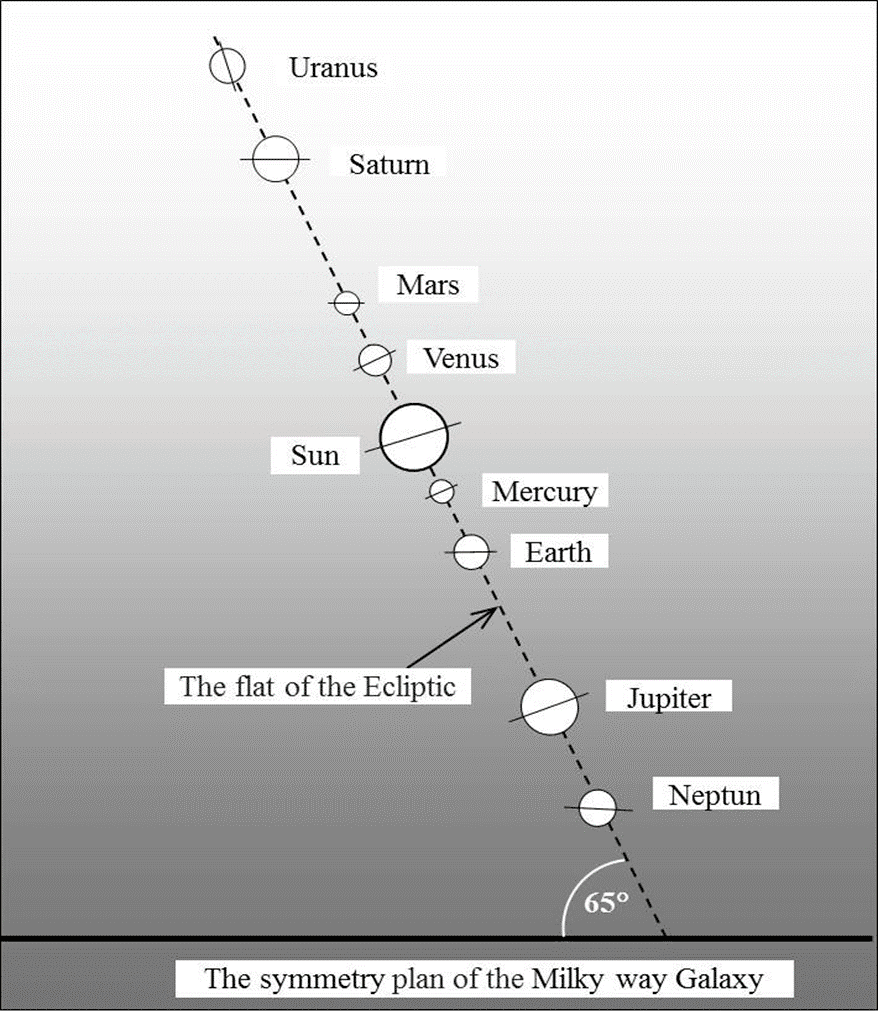
Fig. 6. The inclination of the Ecliptic to the axis of symmetry of the Galaxy
It is noteworthy that the axes of rotation of the Sun and the planets around their own axis are parallel to the plane of symmetry of the Galaxy (or close to it), and the density of the gas-dust medium decreases with a distance from it [4, Fig. 5].
In Fig. 8 shows a view of the Solar System from the Side of the North Star. The dots indicate the north poles of the Sun and the planets. The gravitational potential and, as a consequence, the density of the gas-dust medium of the Galaxy decreases as it moves away from the axis of symmetry of its plane.
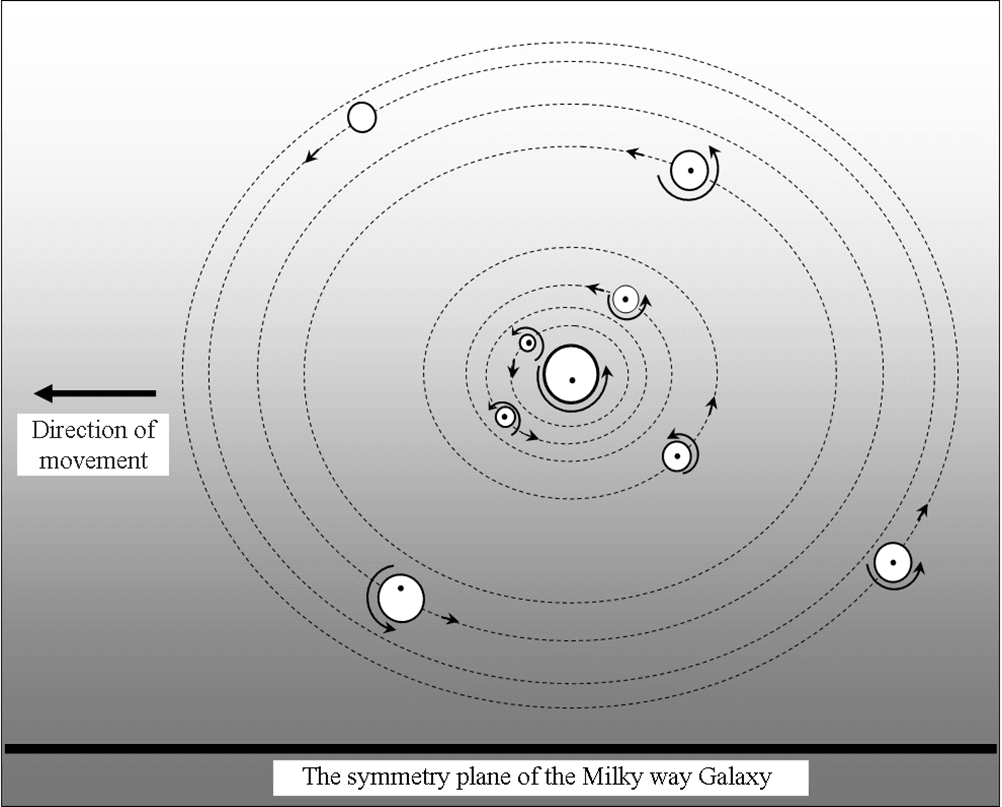
Fig. 7. Rotation of the Sun and planets in the plane of the Ecliptic (view from the North Star)
When the Solar System moves in the direction indicated by the arrow, the Sun and the planets rotate counterclockwise around their axis. The planets of the solar system rotate counterclockwise and in their own orbits. The reason for their rotation both in orbits and around their own axis is to overcome the drag forces of the gas-dust environment of the Galaxy, the density of which varies in a plane perpendicular to the direction of motion of the Solar System.
Let's turn to other known facts related to rotation in the solar system. Within the framework of classical mechanics, the gravitational interaction between two material points of mass M and m is described by Newton's law of universal gravitation:
 ,
,
where: G – the gravitational constant equal to G= 6.674184*10−11 m3 s−2 kg−1;
R – the radius of the planet's orbit.
The gravitational force between the Sun and the planet is F1 = GMS m/R2, and the centrifugal force acting on the planet is F2 = mV2/R.
The planets are kept in orbit around the Sun due to the balanced gravitational (F1) and centrifugal (F2) forces (F = F1 = F2):
 ,
,
where: – mass of the Sun: MS = 1.9885 x 1030 kg;
– heliocentric gravitational constant: GMS = 132 712*1015 м3с−2.
The value of the heliocentric gravitational constant GMS is confirmed by the calculation of the individual parameters of each of the planets of the solar system, presented in table 2.
Table 2
|
Planets |
Orbit radius R, 106 km |
Orbital velocity V, km/s |
Heliocentric gravitational constant |
|---|---|---|---|
|
Mercury |
57.909 |
47.87 |
132 701 |
|
Venus |
108.209 |
35.02 |
132 708 |
|
Earth |
149.598 |
29.793 |
132 787 |
|
Mars |
227.937 |
24.13 |
132 718 |
|
Jupiter |
778.412 |
13.06 |
132 769 |
|
Saturn |
1 426.73 |
9.66 |
133 136 |
|
Uranus |
2 871.97 |
6.8 |
132 800 |
|
Neptune |
4 498.26 |
5.44 |
133 120 |
|
Pluto |
5 906.36 |
4.74 |
132 702 |
A similar confirmation was obtained for the Earth's geocentric gravitational constant: GME = 398,600 km3/s2 (Table 3).
Table 3
|
Earth satellites |
Satellite orbit radius R, km |
Orbital velocity V, km/s |
Geocentric gravitational constant |
|---|---|---|---|
|
Moon |
384 467 |
1.02 |
400 000 |
|
Geostationary satellite |
42 242 |
3.07 |
398 127 |
|
ISS |
6 772 |
7.672 |
398 597 |
The above regularities generally point to a single mechanism supporting the rotation of the Sun and planets.
These patterns generally indicate a single mechanism that supports the rotation of the Sun and the planets.
Among the existing unsolved questions in science are the features of the rotation of Venus – unlike other planets, it rotates around its axis in the opposite direction.
6. REASON FOR THE REVERSE ROTATION OF VENUS
Why does Venus rotate in the opposite (retrograde) direction, counterclockwise? This question has worried scientists for more than a decade. So far, however, no one has been able to answer it.
There have been many hypotheses, but none of them have yet been confirmed. The peculiarity of Venus is that over its equator at an altitude of 65–70 km the wind constantly dominates with a speed of 100 m/s in the direction of rotation of the shell (crust) of the planet. That is, there is a superrotation (super-rotation) of the atmosphere of Venus – this is the rotation of atmospheric layers at a speed exceeding the speed of rotation of the planet itself.
The higher the pressure of the atmosphere on the surface of a space object, the greater its interaction with the interstellar and interplanetary gas-dust medium and the less interaction of the gas-dust medium in the orbit of the object with its crust.
Radar observations conducted in the USSR, the USA and England since 1961 made it possible to determine the rotation period of the planet Venus [7]. It turned out to be the largest in the solar system: 243.16 days with the reverse (retrograde) direction of rotation. The orbital period of Venus is 225 days.
From the standpoint of the laws of mechanics, the drag force acting on a moving object depends on the density of the oncoming flow of the gas medium, and the rotation of the object depends on the gradient of the density of this medium. In order to understand why the planet carries out the opposite (retrograde – clockwise) rotation around its axis, it is necessary to determine the regularity of the density gradient of the medium in the solar system.
The fact that the rotation of Venus and Earth around their axes are multidirectional suggests that the density gradient at the boundary between the orbits of these planets reverses sign. That is, the density of the interplanetary medium from the Sun to this boundary increases, and then, obviously, decreases, as a result of which the rotation of the Earth around its axis is counterclockwise (Fig. 3a). The low density of the interplanetary medium near the Sun and, as a consequence, the corresponding direction of the density gradient can be explained by the impact on it of powerful solar radiation and the properties of the solar atmosphere.
Let us analyze this question in more detail by presenting a diagram of the motion of Venus in its orbit with a characteristic gradient of the density of the interstellar medium relative to the axis of symmetry of the plane of the Galaxy and the interplanetary medium around the Sun (Fig. 9) explaining its rotation around the Sun counterclockwise.

Fig. 9. Rotation of Venus in an orbit around the Sun counterclockwise and around its axis clockwise
The analysis confirms the spread to Venus of the general pattern of rotation of the planets – rotation around its axis due to the action of differential forces of the drag of the interplanetary medium with the corresponding direction of the gradient of its density.
Thus, the reason for the retrograde direction of Venus' rotation around its axis is not the features of this planet, but the opposite (in comparison with the Earth, Mars and other planets) direction of the gradient of the density of the interplanetary medium in its orbit.
7. ROTATION OF THE SUN
Let us consider in more detail the features of the mechanism of rotation of the Sun. If the author determined the mechanism of their rotation relative to the planets of the Solar System, then there were no versions of the causes (mechanism) of the rotation of the Sun itself. There are only observational facts that can be taken as a basis for explaining the reason for the rotation of the Sun. From observations of sunspots, it has long been known that the surface (shell) of the Sun is not a solid body. The book of the Canadian astrophysicist Professor of the University of Montreal J L. Tassul [8] summarizes the results of the long-term development of the theory of the rotation of stars. It is established that the rotation period of the visible outer shell of the Sun varies differentially depending on the heliocentric latitude – the rotation period is minimal at the equator and gradually increases towards the poles. The average rotation period at the solar equator is 25 days. From observations of long-lived sunspots made in Greenwich during 1878-1944, Newton G.W. and Nunn M.L. derived the following formula for daily displacement ((φ):

Based on this dependence, the author of the article builds a graph of the differential rotation of the surface (shell) of the Sun (Fig. 11). From the graph it can be seen that the maximum rotation speed of the shell (14.38 °/day) falls on the equatorial part of the Sun (the relative diameter of the parallel is 1.0) due to the greatest rotational torque of the forces created by the resulting force of the drag drag of the gas-dust medium during the movement of the Solar System in the Galaxy. At the same time, the core of the Sun, as well as the cores of the planets, does not rotate. The drag forces of the gas-dust medium weaken with a decrease in the diameter of the parallels, but the total force leading the shell of the Sun into rotation increases accordingly.

Fig. 10. Characteristic of the differential rotation of the solar envelope
As for the helioseismological studies of the Sun, their results remain doubtful [9] – «The physical conditions of matter on the Sun are relatively mild, and the deviations from the ideal gas equation of state are modest, though still large enough to be investigated using helioseismology. Thus, it may not be unreasonable to hope that even our simple models can provide a reasonable idea of the properties of the solar interior, and this really seemed as discussed in section 5.1.2, at least until the revision of solar abundance (see section 6.2). However, such complacency is clearly naïve, given the potential of the solar interior for complexities far beyond our simple models. As discussed in section 5.1.4, the origin of the current internal rotation of the Sun is not clear... In addition, it should be borne in mind that even relatively successful models, such as model S, show a very significant departure from helioseismic conclusions (see Fig. 39). However, it is possible that the consequences for solar models of the revision of solar composition served as a wake-up call for a revision of the fundamentals of solar modeling».
In connection with the foregoing, it is preferable to explain the immobility of the (non-rotating) core of the Sun by the stability of the position of the Foucault pendulum.
The forces of the frontal (frontal) resistance of the interplanetary medium with the corresponding gradient of its density similarly support the rotation of the planets of the solar system. There is no other explanation for the rotation of the Sun and the planets of the Solar System. If there is another reason (another mechanism of rotation), then why over billions of years, for example, the differential angle of rotation of all parts of the shell of the Sun has not become equal, the same.
8. ROTATION OF ASTEROIDS
Asteroids of the Solar System are celestial bodies orbiting the Sun with a diameter exceeding 30 meters, which have an irregular shape and do not have an atmosphere. Smaller bodies are classified as meteoroids. Of the approximately one million known asteroids, the largest number is located between the orbits of Mars and Jupiter, in the main asteroid belt. The total mass of all asteroids taken together is less than the mass of the Earth's Moon. It is believed that asteroids with a diameter of D >15 km have the structure of a «pile of debris», in which asteroids are gravitationally bound clusters without a supposed internal coupling. Consequently, an asteroid from a pile of debris cannot rotate too fast, otherwise the centrifugal force would overcome gravity, which would lead to the disintegration of the asteroid.
The rotation of asteroids, like planets (except Venus) and comets of the solar system, occurs in one direction – counterclockwise, when viewed from the north pole of the world [10], which is also a confirmation of the reason for the continuous rotation of cosmic objects revealed by the author.
From the collected rotation periods, it was found that the rotation rate limit of C-type asteroids (dark carbonaceous objects, the most common class of asteroids), which have a lower bulk density, is lower than for S-type asteroids (a class of asteroids that include objects with a silicon (rocky) composition). This result is consistent with the overall picture of asteroids similar to piles of debris (i.e. lower bulk density – lower rotational speed limit).
Moreover, the distribution of rotational velocities of asteroids the size of 3<D<1515 km shows a steady decrease in frequency for f > 5 revolutions per day, regardless of location in the main belt.
9. CONCLUSION
The universe, infinite in time and space, consists of matter whose properties can be known. These are intergalactic gas, dust and gas clusters, galaxies, star clusters, and the interstellar medium (latent mass) that are in a mobile state [4]. Galaxies are giant gravitationally bound systems of stars and star clusters, interstellar gas, and dust. All this can be attributed to nebulae [11].
The constant rotation of a group of space objects, as a rule, in one direction – one of the main mysteries of modern science – is explained by the well-known laws of mechanics, in particular the mechanics of frictional interaction (tribomechanics) with interplanetary and interstellar media.
The determining factor in the rotation of space objects is the gradient of the density of the medium - the differential dependence (change) of the density of the interstellar and interplanetary medium on the gravitational potential in the zone of their location. For example, the density of air on Earth decreases with altitude, the air becomes more dispersed. A similar pattern, for example, occurs in the Solar System [12].
Based on the laws of mechanics, the proposed approach gave a simple explanation: when space objects (planets, asteroids, the Sun, galaxies) move in an environment with varying density in a plane perpendicular to the direction of their motion, the resulting (differential) force of the frontal (frontal) resistance of the gas-dust medium acts, which supports the continuous rotation of these objects, that is, it balances the frictional force of the medium on the surface of the object, inhibiting its rotation.
The rotation of objects (satellites, planets, stars) in this article means the rotation of the atmosphere, crust, mantle of these objects, and not their cores, which are predominantly stationary relative to the center of the Galaxy due to their fixation by the comprehensive cumulative effect on them of electromagnetic waves emitted by other objects of the Universe. An exception may be some satellites of planets, for example, the Moon, asteroids that do not have molten cores.
THE RESULTS OF THE RESEARCH:
1. The cause and nature of the rotation of space objects are identified and substantiated. The continuous rotation of space objects is ensured by the influence of balancing forces on them:
- the frictional forces of the gas-dust medium on the surface of the object, which inhibits the rotation of the space object;
- is the resulting differential drag forces of the gas-dust interstellar and interplanetary medium with variable (gradient) density in the corresponding orbit of motion, changing in a plane perpendicular to the direction of motion of the object.
2. The direction of rotation of the Sun and the planets around the Sun depends on the direction of motion of the Solar System and the density gradient of the interstellar medium relative to the plane of symmetry of the Galaxy.
3. The direction of rotation of the planets of the Solar System around their axis depends on the gradient of the density of the interplanetary gas-dust medium in the orbit of each of the planets, mainly relative to the Sun.
4. Venus rotates in a retrograde, that is, in the opposite direction relative to other planets. Consequently, the density gradient of the gas-dust medium in the orbit of Venus also has the opposite meaning compared to the density gradient in the orbits of other planets.
5. The nature of the rotation of the planets and the Sun indicates that only their atmosphere, crust, shell and mantle rotate. The cores of satellites, planets, the Sun and other stars are stationary relative to the center of the Galaxy.
6. The forces of friction and differential drag of the gas-dust medium, which prevent the movement and rotation of space objects, depend on its properties in the orbit of the corresponding object.
7. The speed and direction of rotation of a moving space object depends not only on the gravitational potential of the surrounding space acting on it, but also on the totality of the following factors interacting:
- the composition, density and density gradient of the interplanetary medium in the orbit of each object (planet);
- properties of the atmosphere and shells of planets (for example, on Venus, the interplanetary medium interacts with its dense atmosphere, and not with the solid shell of the planet);
- properties of the mantle of the planets (temperature, density, viscosity);
- the size, mass and shape of objects.
The author used the theoretical method of physical research, which makes it possible to indirectly know a real object or phenomenon on the basis of studying the corresponding mental model. A numerical assessment of the rotation of space objects, taking into account the real differential density (density gradient) of the environment in which they move, is the subject of a separate study.

.png&w=640&q=75)